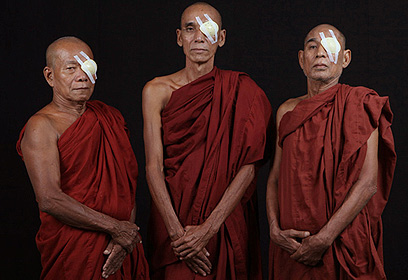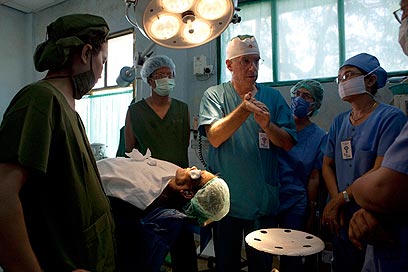
Israeli medical team saves sight in Myanmar
NPO organization Eye from Zion sends Israeli senior ophthalmologists to one of the world's most impoverished countries. Two of them offer special insight into their journey
This scene was destined to be one of many; gratitude expressed by people who would have lost their eyesight and their place within an impoverished society that cannot care for its poor– if not for us.
The Hippocratic Oath we took when we graduated from medical school takes on a new meaning in a place like this.
We were part of a seven-person mission to Myanmar, sponsored by Eye from Zion, a non-profit humanitarian organization, founded by Israeli businessman Nati Marcus, with aim of providing medical assistance to the world's needy.

Monks after surgery (Photo: Vardi Kahana)
Eye from Zion enjoys the cooperation of Mashav – the Foreign Ministry's National Agency for International Cooperation, the American Jewish Joint Distribution Committee (JDC) and Magen David Adom, as well as the support of Hanita lenses (TEVA GROUP) and numerous commercial and private bodies.
Our destination of choice: Myanmar. Bordering Thailand, Laos, China, Indian and Bangladesh, Myanmar is a poor, struggling county ruled by a military junta – a regime which has left it shunned by the West. The only aid it gets comes via private foundations and independent volunteers.
Our mission included four surgical ophthalmologists: Dr. Tzvi Segal head of the Ophthalmology Department at the Nahariya Medical Center, Dr. Shmuel Levartovsky, head of the Ophthalmology Department at the Barzilai Medical Center in Ashkelon, Dr. Nadav Belfair, senior ophthalmologist at the Soroka University Medical Center in Beersheba and Dr. Nirit Bourla, senior ophthalmologist at the Chaim Sheba Medical Center at Tel-Hashomer.
Joining us were medical technician Hovav Nutman and photographer Vardi Kahana. Eye from Zion Founder and Chairman Nati Marcus headed the team.
Bamboo and blackouts
Our journey began in the southern Myanmar city of Pyapon – one of the cities most severely struck by Cyclone Nargis in 2008.
Near the local hospital's main building, under ever-present bamboo sheds, we could see dozens of patients waiting for us. No complaints, no grievances and no favoritism – just waiting patiently for their turn.
Their numbers, as we soon found out, continued to grow.
Inside the hospital, rows and rows of peeling, white iron beds were stationed in every room. With the absence of mattresses, patients lay on mats places on the beds. The operating rooms turned out to share one air conditioner. The temperature in the ORs could climb to 30 degrees Celsius and doubts of whether we could perform under such conditions began creeping in.

Dozens of patients waiting for us (Photo: Vardi Kahana)
Between unpacking the equipment and preparing the ORs, and with the humidity taking its toll, we began patient triage, ahead of the next day's surgeries.
After the first two patients were prepped for surgery, we found out two things: First – one of the two phacoemulsification machines used in cataract surgeries had malfunctioned; and second – the local surgical support staff spoke only the most basic English, making vital communication very difficult.
We were in the middle of a procedure when all of a sudden the lights went out. Power failures are common in Myanmar and the local medical team had flashlights standing by to light the operating field, but they did little to assist, since they could not take the place of the much needed light microscope. And so, our only recourse was to wait.
Our next day spelled another surgical marathon. This time, we demonstrated procedures for the benefit of the local doctors, in hope that what ever knowledge we could share would help them provide better care for their patients.
After intensive week we bid Pyapon farewell and headed 445 miles north of Yangon to Mandalay, Myanmar's second largest city.
Mixed emotions in Mandalay
We arrived in Mandalay on Sunday and headed straight to the local hospital. After meeting the local staff and setting up, we began examining the dozens of patients waiting for us.
We were quickly joined by Mou, the head nurse, who was tasked with helping us communicate with both doctors and patients, thanks to her relatively good English. Here too, we found that the staff spoke only basic English, but with Mou and her fellow nurses' help and efficiency, everything went smoothly.
We spent our time at the Mandalay hospital operating on patients and teaching and advising the local medical team.

Teaching local doctors (Photo: Vardi Kahana)
Our feelings of helplessness at seeing cases where patients suffering from retinal detachment were doomed to lose their sight simply due to the lack of available medical care, were relieved only by the fact that we were able to aid patients suffering from other problems, by performing procedures to improve or save their eyesight.
Israeli Ambassador to Myanmar Yaron Mayer organized a special reception for us on our last night in Mandalay. It marked the end of two fast-paces week after which were went back to our families, our lives and our daily practice of medicine. But Myanmar, with is warm people and beauty, which seems to be frozen in time, will always be in our hearts.
Dr. Nirit Bourla is a senior ophthalmologist at the Chaim Sheba Medical Center at Tel-Hashomer. Dr. Nadav Belfair is a senior ophthalmologist at the Soroka University Medical Center in Beer-Sheva
For more information, please contact: [email protected]










